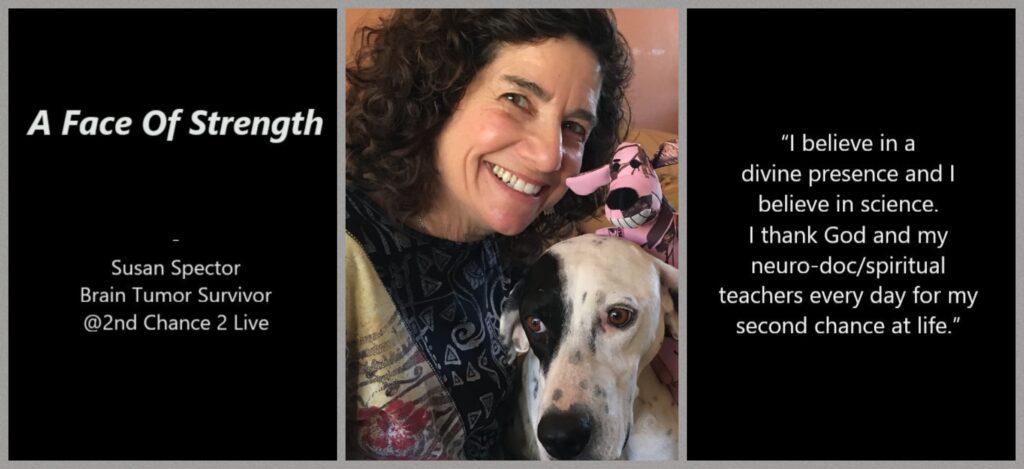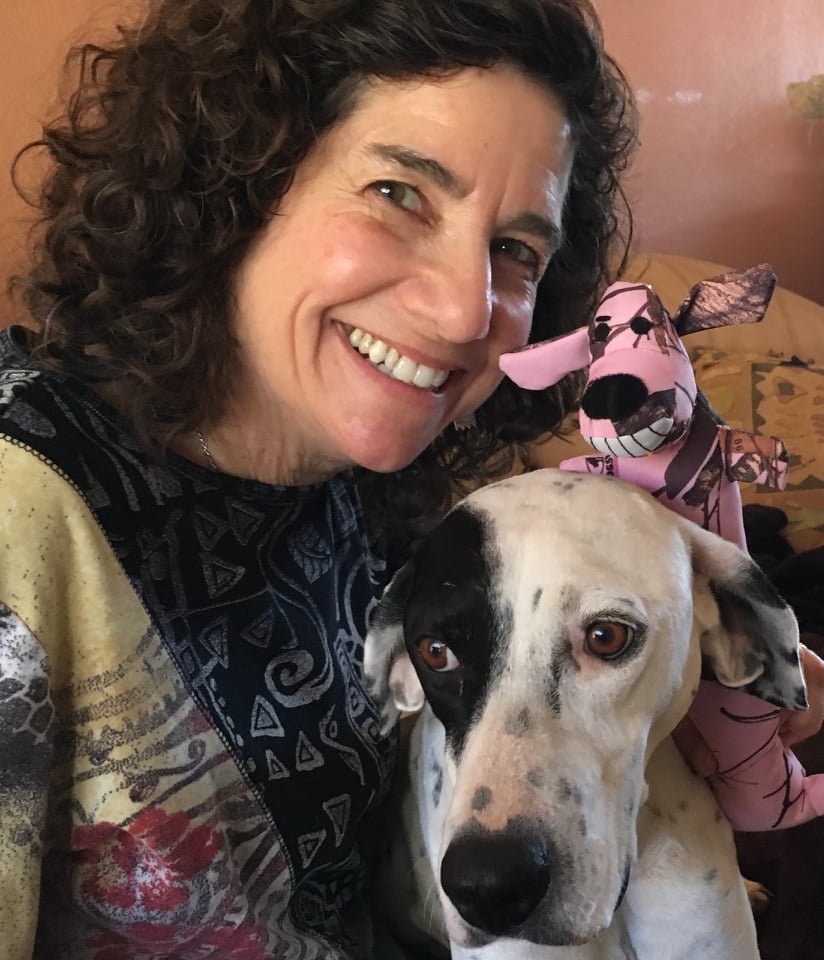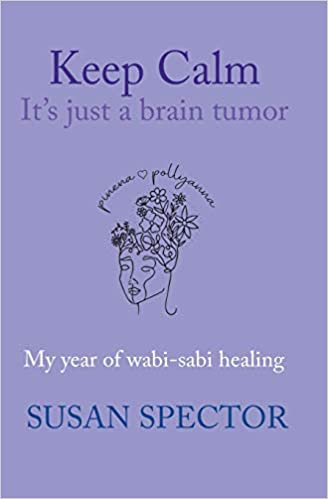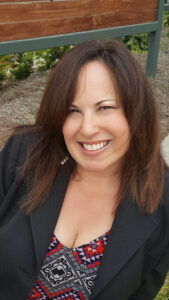“The doctors are treating the body and it’s my job to figure out how to treat my mind and soul.”
-Susan Spector
An Interview with: Susan Spector, author of “Keep Calm It’s just a brain tumor: My year of wabi-sabi healing.”
Chances are if you’ve ever eaten sushi you’ve heard of the Japanese horseradish called Wasabi. Are you, however, familiar with the Japanese philosophy called wabi-sabi? There are many who say the wabi-sabi lifestyle is the secret to happiness.
In her memoir, “Keep Calm It’s just a brain tumor: My year of wabi-sabi healing” brain tumor survivor, Susan Spector, writes about how she learned to create a wabi-sabi lifestyle which helped her to cope with the uncertainty of life after brain surgery and find gratitude in both impermanence and imperfection. As a fellow brain tumor survivor or “brain buddy” as Susan affectionately calls us, I have found brain tumor survivors to be some of the strongest and most resilient people in the world. Reading and interviewing those who have written about their experiences has helped me to accept and embrace my new normal and I’m grateful to have a platform to share what I am learning with you.
Today, I have the honor of interviewing Susan, and let me just say for anyone open to learning about mindfulness and gratitude, there are transformative diamonds to be discovered throughout her book. I say that not only as a “brain buddy” but also as a perfectionist, former workaholic, and someone battling multiple chronic illnesses.
“My dream and aspiration are to cultivate a gratitude practice in the midst of the inevitable health challenges that are a natural part of life, no matter what.”
Wendy: Welcome Susan. Thank you for writing such an engaging memoir about your brain tumor experience. Can you please summarize your story for the readers of this blog?
Susan: Sure! I was bouncing along in my unaware privileged life, happily retired when suddenly it all came crashing down. A two-centimeter mass in my pineal gland (aka Pinena) started rearranging furniture and clogged up my plumbing. My brain started filling up with water (cerebral spinal fluid) and I was diagnosed with life-threatening obstructive hydrocephalus. I lost control of my body and mind. By the grace of God and a team of brilliant neurosurgeons at the Mayo Clinic in Phoenix, AZ (also known as “The Emerald City”), and an ETV – an endoscopic third ventricle ventriculostomy (a modern medicine miracle) surgery was performed and it gave me back my life. Now, in my “2nd Chance 2 Live” chapter, I had to figure out what that meant and why I was here.
Wendy: Incredible! Your experience led you to develop a practice and lifestyle around the concept of wabi-sabi. What does it mean to live a wabi-sabi lifestyle and oh, by the way, do you like Wasabi?
Susan: Once on a road trip in the Florida Keys, I fell slightly ill from eating too many wasabi flavored peanuts and swore off wasabi for life. Years later, as life would have it, I became a student and practitioner of the wabi-sabi way.
Wabi-sabi is a Japanese philosophy that celebrates the sublime joy in the beauty and spirituality of imperfection. A classic example is when an artist creates a teacup, a perfect piece of pottery. The teacup gets fired in the kiln and out it comes, cracked. Instead of crying, the artist fills the cracks with gold lacquer and the teacup suddenly becomes more interesting. Wabi-sabi sees value in natural states of decay, like the things happening to the cells in our body, every second of every day. I have a broken brain, a cracked teacup. And it’s perfectly imperfect.
“I understand and appreciate how my unique flaws, my brain tumors, have led me to my greatest strengths and treasures, a grateful outlook being the biggest treasure of all. I am continuously learning how to embrace the impermanence of all things as the natural order and accept the good and inevitable pain of life with grace and gratitude.”

Wendy: Your dog is beautiful! What is her name and what has she taught you about, “the truth of this moment?”
Susan: Paisley is a dog, a good girl, a teacher, and a place of refuge. Cameron is my human soulmate and she is my animal one. She wakes up happy, expecting to have her best day ever. She eats the same breakfast every day and jumps four feet in the air when it is served, anticipating her best meal ever. Twice a day, when I pick up her leash, she twirls and jumps in circles, unable to mask her enthusiasm in expectation of her best walk ever. She trembles with excitement when she spots a squirrel or a bird, wagging her tail with delight. She keeps me moving, gratefully, walking five miles a day. Before the BS (brain surgery), I couldn’t walk to the bathroom without a walker. The only time I won’t follow her lead is when she delights in rolling in the dead and smelly things she regularly finds on her treasure hunts.
Wendy: Oh my gosh, that last part is too funny! Okay so now I have to ask, what is Kintsugi, and how does the concept relate to your brain surgery?
Susan: Kintsugi is the art and process of repairing broken pottery with golden lacquer so that the mended pieces can be transformed from flaws to new and imperfect beauty. Sometimes I call my neurosurgeon Dr. Kintsugi, because he is the artist who used my third ventricle as his canvas, repaired the leaky flaws (blocked cerebral spinal fluid), and let me flow and shine my light again!
Wendy: Oh, how I love that concept!
Tell us about your brain tumors, Susan. Where are they located, what did you name them, and what did naming them do for you?
Susan: Pinena is a two-centimeter tumor inside my pineal gland and Pollyanna is a smaller group of rogue cells in my foramen magnum. I never expected to name them, until the universe spoke and I listened. Once they had names, they became friendly entities. We chat and they inspire me to write. We’ve made a truce and I am no longer as frightened as I was when I first learned about them.
Wendy: Interesting! It’s great that personifying your tumors helped you to accept them. I had a naming contest for my tumor. I thought I was being clever then a few months after my craniotomy (when I became active in the brain tumor community) I realized that re-naming our tumors is actually pretty common. Nothing like brain tumor humor.
Anyhow, next question…what the heck is a Zen koan?
Susan: Funny you ask, Wendy – my brain tumor Pinena asked the same question! It’s a small phrase used to train people in meditation practice. Zen masters say koans can change how you live in the world by provoking insight and revealing truths about ourselves and the world. My koan was born out of my treatment protocol: “watch and wait” (I added trust to the protocol). My koan is with me moment-to-moment. It is simple, but not an easy practice. It is the best and only way I know how to turn a wabi-sabi philosophy into a personal lifestyle.
Wendy: The watch and wait (and trust) protocol. I am certain that concept will help other survivors. I’m currently on the watch and wait protocol and I will definitely be adding trust to it as well.
With all of your insights, what have your brain tumors revealed as your biggest life lessons and self-discoveries?
Susan: If I had to boil down my memoir to six words, it would be “Take nothing and nobody for granted.”
“Take nothing and nobody for granted.”
Wendy: Yes! I’m taking a moment right now to imagine what the world would be like if everyone lived by those six words.
…Well, that was peaceful.
Okay, back to the interview, your book is divided into two parts, before brain surgery (BS), and after surgery. Can you provide an example of what your life was like before brain surgery and how things changed after brain surgery?
Susan: Before the BS (pun obviously intended!), life, in general, was safe, predictable, easy, and pleasant. I wasn’t really awake. I worried about silly material stuff I had no control over, like the possibility of my aging septic tank failing or my 17-year-old car breaking down and leaving me stranded. I didn’t yet know it, but deep inside the middle of my brain, things were going rogue and real chaos was about to explode. After the BS, I am more awake, learning and practicing how to be less worried about what might be next and more grateful for what is actually happening now, in this moment.
Wendy: Beautiful! You speak about the importance of breath and the four-Square method, can you please explain what that is?
Susan: When my grandmother was 100 years old, she said, “Susie, I am now going to tell you the secret of living a long life.” I perked up. “You keep breathing.” She had a great sense of humor and today I find humor and the blessing of laughter go a long way in dealing with painful and humiliating situations (like urinary incontinence before my miracle surgery). These days, I take my grandmother’s wisdom about breathing, but I slow it down. I gratefully inhale the gift of life with a slow deep breath to the count of four beats. I gaze at the gift, in awe, and count another four beats. I then return the breath to the universe, the source, slowly counting to four and rest in gratitude for four more. Not only does this breath rhythm method strengthen my gratitude practice, but it also calms my body and my monkey mind. Every time I am inside an MRI machine, filling up with scanxiety and judgment on the “evil” Gadolinium push, I will add an overlay of Jewish prayer to the rhythm and say a “Baruch Hashem” a well-known Jewish expression that translates to “Thank God” for the privilege of my world-class medical care.
“… I find humor and the blessing of laughter go a long way in dealing with painful and humiliating situations…”
Wendy: You battled a serious autoimmune disease for several years prior to your brain tumor diagnosis so you were used to not feeling well. What were a few of the symptoms that triggered you to suspect that, “something more sinister was at play?”
Susan: Classic symptoms of hydrocephalus – wet, whacky, and wobbly. I had poor balance, incontinence, and a foggy brain. I was forgetful and confused. I self-misdiagnosed it as Parkinson’s since these conditions present the same way and I was very familiar with Parkinson’s. My mother died of the disease.
Wendy: I’m sorry for the loss of your mother. May she rest in peace. Parkinson’s is another horrific and often misunderstood disease of the brain.
You spoke about the month you spent in outpatient occupational therapy during your recovery. Tell us about that. What were some of your goals?
Susan: I spent a month in occupational therapy to work on visual perception deficits and reduce the amount of time it took between my brain seeing things and understanding what to do with that visual information. I needed to build my confidence up to get behind the wheel of a car again. As it turns out, I realized I was a bit of kvetch. This is what we call complaining, in Jewish speak. I complained to my therapist about some of the visual tests, and proudly declared myself “a complainer.” Jewish folk like me consider it as a bit of an art form. That was then. Now I choose to not be a complainer because I understand that it’s not possible to live gratefully and complain about things not being as I want them to be. Living gratefully is way better!
Wendy: You just reminded me of my occupational therapy. I recall learning how to drive again as well. During one session, I remember seeing and hearing an ambulance approaching but it took a few minutes for me to process what it was before I realized, ‘Oh I need to pull over.’
On another note, you reflected a lot about the gratitude you felt after your surgery. What were/are you most grateful for?
Susan: First the obvious – my super-hero-mensch-boyfriend Cameron. Next, my family, friends, and brilliant neuro docs. When people tell me how brave I am, I say I had no choice. My neuro docs are truly the brave ones, choosing to do this life-saving work, day in and day out. I am also grateful for my hard-won acceptance and the magical moments when my spirituality curriculum from a Jewish perspective intersects with my writing practice.
“When people tell me how brave I am, I say I had no choice. My neuro docs are truly the brave ones, choosing to do this life-saving work, day in and day out.
Wendy: How have you been able to utilize mindfulness to calm scanxiety?
Susan: When scanxiety pops up as I get closer to each regular MRI, I remember to ask, “In this very moment, other than my thoughts about past or future, what exactly is the problem?” The next scan may show tumor growth or ETV failure. New treatment protocols may be needed. The answer to the question… all I know and all I need to know is that right now, in this moment, I am okay. Living with brain tumors is like dropping into a master class in applied mindfulness. It’s a lifetime study and practice.
“When scanxiety pops up as I get closer to each regular MRI, I remember to ask, “In this very moment, other than my thoughts about past or future, what exactly is the problem?”
Wendy: You wrote, “I am grateful for the unexpected gift of finding my writer’s voice. Thank you, Pinena. And thanks to you too, Pollyanna, for the reminder to say so.” How do you know which tumor to thank for what?
Susan: For a long time, I never acknowledged, thanked, or even named Pollyanna because the neuro docs blew her off as “just a little Schwannoma or Meningioma.” But then one day I realized she could serve as my small but mighty reminder to cultivate gratitude in the midst of the inevitable health challenges that are a natural part of aging. Pinena, on the other hand, is known as the bigger troublemaker and I thank her for reminding me how life can change on a dime and how precious, fragile, and radically amazing it is. Both served as muses as I wrote my memoir and I give them a big shout-out for their inspiration. Writing and the power of language was something I discovered through them. I never had any literary aspirations before this adventure, but telling my story, learning about language, and the craft of writing would not have happened without them. They indirectly introduced me to the healing power of writing. I learned about the power of prepositions, and am comforted learning that I will likely die WITH my brain tumors, not FROM them. I may not understand how it works on brain healing, but I know creative writing is a big part of my brain recovery. I write to find out what’s important, how to live and serve. In a peculiar way, Pinena and Pollyanna continue to serve me.
“I may not be able to understand it, but I know the technique of creative writing is helping my brain in the recovery process. It helps keep me focused and grateful for my tumor “gifts.”
Wendy: Thank you so much for your time, Susan. Is there anything else you would like to add before concluding this interview?
Susan: Yes, thank YOU, Wendy, for reading my story and coming up with these amazingly thoughtful questions. I first knew you through the voice and visibility you give to others in your “A Face of Strength” campaign. It wasn’t until much later, I got to hear your story through a podcast and realized what a badass you are! Your generosity and service to the brain tumor/cancer community are remarkable!
“If this is the new normal, then I’ll take it. Learning to gratefully and gracefully accept the impermanence of all things in life.”
-Susan Spector, “Keep Calm It’s just a brain tumor: My year of wabi-sabi healing.”




 Hello. My name is Wendy and I’m a recovering workaholic. I'm also a brain tumor/cancer survivor.
The purpose of this blog is to share my experiences, memories, resources, and self-discoveries as I continue to transform from a workaholic into a more balanced person. I have read several books and stories about others who have had similar experiences
Hello. My name is Wendy and I’m a recovering workaholic. I'm also a brain tumor/cancer survivor.
The purpose of this blog is to share my experiences, memories, resources, and self-discoveries as I continue to transform from a workaholic into a more balanced person. I have read several books and stories about others who have had similar experiences 